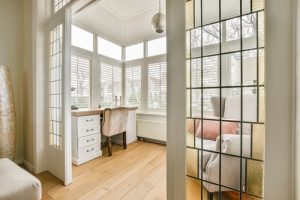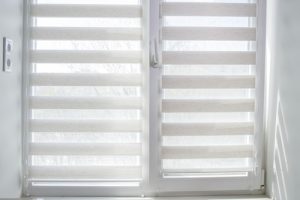Plantation door shutters are a stylish and functional addition to any home, offering privacy, light control, and a classic aesthetic appeal. They are especially popular in regions with warm climates, such as the Southern United States, due to their ability to keep interiors cool while providing a timeless look. This comprehensive guide will delve into the various aspects of plantation door shutters, including their benefits, types, materials, installation processes, maintenance tips, and design ideas, ensuring that homeowners can make informed decisions and enjoy their shutters for years to come.
Benefits of Plantation Door Shutters
Plantation door shutters offer numerous advantages that make them a preferred choice for many homeowners. Here are some of the key benefits:
1. Aesthetic Appeal
Plantation shutters add a touch of elegance and sophistication to any home. Their clean lines and classic design can complement a wide range of interior styles, from traditional to contemporary.
2. Light Control
The adjustable louvers of plantation shutters allow homeowners to control the amount of natural light entering a room. This feature is particularly useful for reducing glare and protecting furniture and flooring from UV damage.
3. Privacy
Plantation shutters provide excellent privacy without compromising on aesthetics. By adjusting the louvers, homeowners can block the view from outside while still allowing light to filter through.
4. Energy Efficiency
Plantation shutters offer an additional layer of insulation, helping to regulate indoor temperatures. In warm climates, they can keep interiors cool by blocking out the sun’s heat, potentially reducing energy costs.
5. Durability
High-quality plantation shutters are built to last. They are made from durable materials that can withstand daily use and environmental factors, ensuring long-term functionality and beauty.
6. Low Maintenance
Compared to other window treatments, plantation shutters are relatively low maintenance. Regular dusting and occasional cleaning are usually sufficient to keep them looking their best.
Types of Plantation Door Shutters
Plantation door shutters come in various styles and configurations, each suited to different types of doors and personal preferences. Here are some common types:
1. Full-Height Shutters
Full-height shutters cover the entire height of the door, providing maximum privacy and light control. They are ideal for patio doors, French doors, and sliding doors, offering a cohesive and streamlined look.
2. Café-Style Shutters
Café-style shutters cover only the lower portion of the door, leaving the upper part open for natural light. This style is perfect for rooms where privacy is needed at a lower level while maintaining an open and airy feel.
3. Tier-on-Tier Shutters
Tier-on-tier shutters consist of two separate panels that can be operated independently. This design allows for greater flexibility in controlling light and privacy, making them suitable for doors with tall windows.
4. Bifold Shutters
Bifold shutters are designed to fold neatly to one side, making them an excellent choice for sliding doors. They provide easy access to the door while offering the benefits of plantation shutters.
5. Sliding Shutters
Sliding shutters operate on a track system, sliding horizontally to open and close. They are ideal for large doors and can be a space-saving solution in areas with limited room for traditional hinged shutters.
Materials Used in Plantation Door Shutters
The choice of material significantly impacts the appearance, durability, and maintenance of plantation door shutters. Here are the most common materials used:
1. Wood
Pros:
- Offers a traditional and warm aesthetic
- Can be painted or stained to match any décor
- Durable and long-lasting with proper care
Cons:
- Susceptible to moisture damage and warping
- Requires regular maintenance to preserve appearance
Best Practices:
- Choose hardwoods like basswood or poplar for better resistance to warping.
- Apply a high-quality sealant to protect against moisture.
2. Vinyl
Pros:
- Highly resistant to moisture and humidity
- Durable and low maintenance
- Affordable compared to wood
Cons:
- Limited color options
- May not have the same natural look as wood
Best Practices:
- Opt for high-quality vinyl to ensure longevity and a better finish.
- Regularly clean with mild soap and water to maintain appearance.
3. Composite
Pros:
- Combines the look of wood with the durability of synthetic materials
- Resistant to moisture, warping, and fading
- Low maintenance
Cons:
- Can be more expensive than vinyl
- Limited customization compared to real wood
Best Practices:
- Ensure proper installation to maximize durability.
- Clean regularly to maintain appearance and prevent buildup.
Installation Process
Proper installation is crucial for the functionality and longevity of plantation door shutters. Here’s a step-by-step guide to installing these shutters:
1. Measure the Door
Accurate measurements are essential to ensure a perfect fit. Measure the width and height of the door, taking into account any trim or molding. It’s advisable to measure at multiple points (top, middle, and bottom) to account for any variations.
2. Choose the Mounting Style
Decide between inside or outside mount:
- Inside Mount: The shutters are installed within the door frame, offering a clean and streamlined look. Suitable for doors with deep frames.
- Outside Mount: The shutters are mounted outside the door frame, ideal for doors with shallow or uneven frames.
3. Assemble the Shutters
If the shutters come unassembled, follow the manufacturer’s instructions to assemble the panels, louvers, and frame. Ensure all components are securely attached.
4. Install the Frame
Position the frame in the desired location (inside or outside mount) and mark the screw holes. Drill pilot holes and use screws to secure the frame to the door or surrounding wall. Ensure the frame is level and square.
5. Attach the Shutters
Hang the shutter panels on the frame using the provided hinges. Adjust the panels to ensure they open and close smoothly. If necessary, make minor adjustments to the hinges or frame to achieve proper alignment.
6. Final Adjustments
Check that all louvers operate smoothly and make any final adjustments to the hinges or frame. Tighten any loose screws and ensure all components are securely fastened.
Maintenance Tips for Plantation Door Shutters
Proper maintenance is essential to keep plantation door shutters looking their best and functioning smoothly. Here are some maintenance tips for different types of shutters:
1. Wooden Shutters
Cleaning:
- Dust weekly with a microfiber cloth or feather duster.
- Use a vacuum with a brush attachment for thorough dust removal.
- Wipe with a damp cloth and mild wood cleaner for deeper cleaning, then dry immediately to prevent moisture absorption.
Maintenance:
- Inspect for signs of moisture damage, such as warping or mold, and address immediately.
- Reapply sealant or finish as needed to protect against humidity.
- Lubricate hinges and louver mechanisms with silicone spray to ensure smooth operation.
2. Vinyl Shutters
Cleaning:
- Dust regularly with a microfiber cloth or duster.
- Clean with a mixture of mild soap and water, then wipe dry.
- Avoid using abrasive cleaners that can scratch the surface.
Maintenance:
- Check for loose or damaged louvers and repair or replace as necessary.
- Ensure hinges and mechanisms are operating smoothly; lubricate if needed.
3. Composite Shutters
Cleaning:
- Dust with a soft cloth or duster regularly.
- Clean with a mild soap solution and water, then dry thoroughly.
- Avoid harsh chemicals that could damage the composite material.
Maintenance:
- Inspect for any signs of damage or wear and address promptly.
- Keep hinges and moving parts well-lubricated for smooth operation.
Design Ideas for Plantation Door Shutters
Plantation door shutters can enhance the aesthetic appeal of any room. Here are some design ideas to inspire homeowners:
1. Classic White Shutters
White shutters are timeless and versatile, complementing any interior style. They can create a bright and airy feel, making rooms appear larger and more inviting.
2. Stained Wood Shutters
Stained wood shutters add warmth and richness to a room. Choose a stain that matches or complements your existing wood furniture and trim for a cohesive look.
3. Bold Colored Shutters
For a more contemporary and dramatic effect, consider painting your shutters in a bold color. This can create a striking focal point and add personality to your space.
4. Shutters with Decorative Hardware
Enhance the look of your shutters with decorative hardware, such as ornate hinges and handles. This can add a touch of elegance and sophistication to your doors.
5. Custom Shutters for Unique Doors
Custom plantation shutters can be made to fit doors with unique shapes and sizes, such as arched or French doors. Tailored shutters ensure a perfect fit and enhance the architectural features of your home.
Enhancing the Longevity of Plantation Door Shutters
To maximize the lifespan of plantation door shutters, consider these additional tips:
1. Protect Against Moisture
In humid climates, moisture can be a significant concern. Ensure proper ventilation in rooms with plantation door shutters to reduce humidity levels. Use dehumidifiers and exhaust fans in areas like bathrooms and kitchens.
2. UV Protection
Protect shutters from UV damage by applying UV-protective films to windows or using curtains and blinds to block out harsh sunlight. This can prevent fading and warping over time.
3. Regular Inspections
Conduct regular inspections of your shutters to identify any signs of damage or wear. Addressing issues promptly can prevent further damage and extend the life of your shutters.
4. Professional Maintenance
Consider hiring professionals for annual maintenance to ensure your shutters are in optimal condition. Professionals can perform thorough cleaning, lubrication, and repairs that may be beyond the scope of DIY maintenance.
Environmental Considerations
When choosing plantation door shutters, consider the environmental impact of your choices. Here are some tips for making eco-friendly decisions:
1. Sustainable Materials
Opt for shutters made from sustainable materials, such as FSC-certified wood or recycled composite materials. These options reduce the environmental impact of your purchase.
2. Energy Efficiency
Plantation shutters can improve energy efficiency by providing insulation. Choose shutters with high insulating properties to reduce energy consumption and lower your carbon footprint.
3. Low VOC Finishes
Select shutters with low VOC (volatile organic compound) finishes to improve indoor air quality and reduce harmful emissions. This is particularly important for homes with children and pets.
4. Longevity
Investing in high-quality, durable shutters reduces the need for frequent replacements, minimizing waste and resource consumption. Proper maintenance further extends their lifespan, making them a more sustainable choice.
Conclusion
Plantation door shutters are a beautiful and functional addition to any home. By understanding the different types, materials, installation processes, and maintenance requirements, homeowners can make informed decisions and enjoy the benefits of these classic window treatments for years to come. Whether you choose wood, vinyl, or composite shutters, proper care and maintenance are essential to ensure they remain in top condition. With a variety of design options available, plantation door shutters can enhance the aesthetic appeal of any room while providing privacy, light control, and energy efficiency. By considering environmental factors and investing in quality materials, you can make a sustainable choice that adds lasting value to your home.

